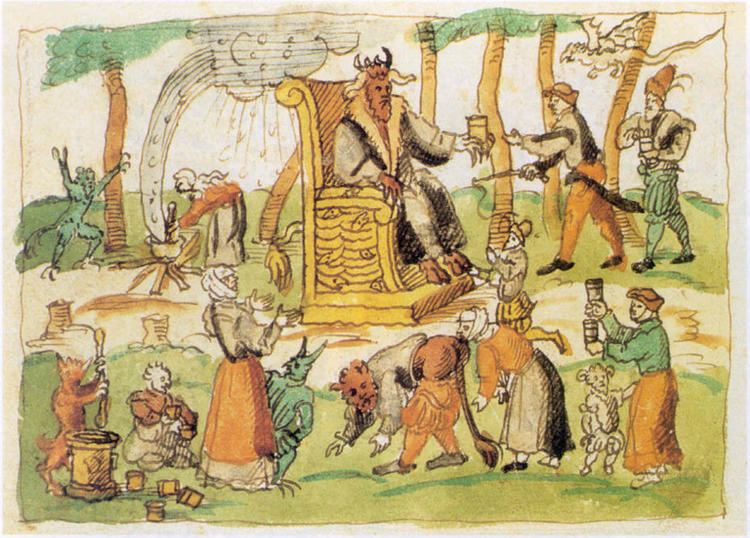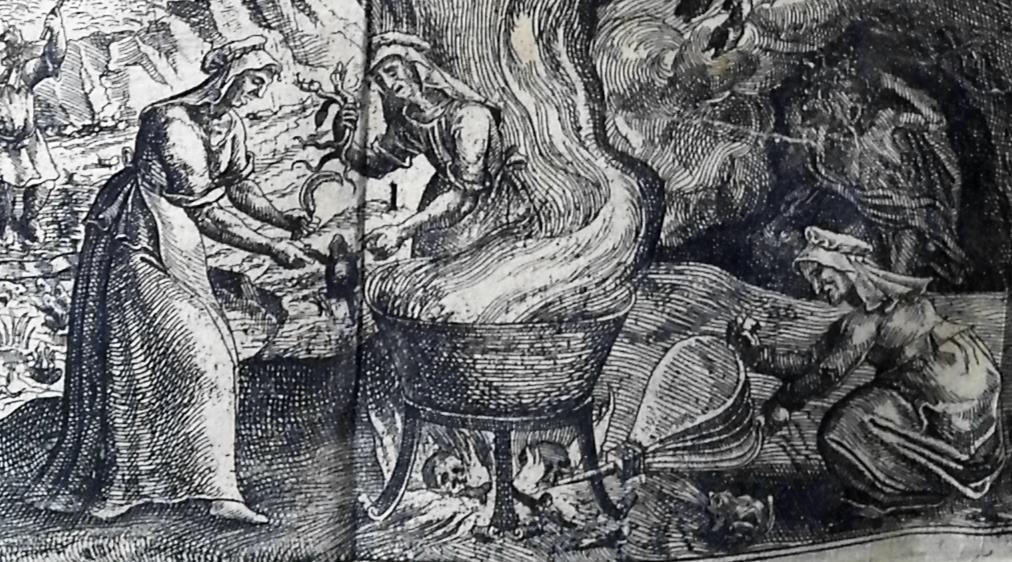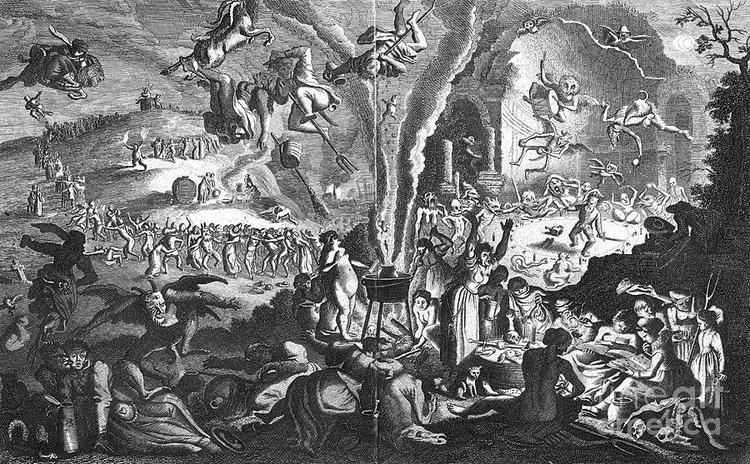 | ||
Berlioz dream of a witches sabbath
The Witches' Sabbath or Sabbat is a meeting of those who practice witchcraft and other rites.
Contents
- Berlioz dream of a witches sabbath
- Etymology
- Ritual elements
- Location
- Dates
- Depictions of witches sabbaths in various art forms
- Disputed accuracy of the accounts
- Possible connections to real groups
- References
European records indicate cases of persons being accused or tried for taking part in Sabbat gatherings, from the Middle Ages to the 17th century or later.

Distinguishable features that are typically contained within a Witches' Sabbat are assembly by foot, beast, or flight, a banquet, dancing and cavorting, and sexual intercourse.

Etymology

The English word "sabbat" is of obscure etymology and late diffusion, and local variations of the name given to witches' gatherings were frequent. "Sabbat" came indirectly from Hebrew שַׁבָּת (Shabbath, "day of rest"). In modern Judaism, Shabbat is the rest day celebrated from Friday evening to Saturday nightfall; in modern Christianity, Sabbath refers to Sunday, or to a time period similar to Sabbath in the seventh-day church minority. In connection with the medieval beliefs in the evil power of witches and in the malevolence of Jews and Judaizing heretics (both being Sabbathkeepers), satanic gatherings of witches were by outsiders called "sabbats", "synagogues", or "convents".

Although allusions to Sabbats were made by the Catholic Canon law since about 905, the first book that mentions the Sabbat is, theoretically, Canon Episcopi, included in Burchard of Worms's collection in the 11th century. The Canon Episcopi alleged that "Diana's rides," (by the name of the Roman goddess of the hunt) were false, and that these spirit travels did not occur in reality. Errores Gazariorum later evoked the Sabbat, in 1452.

In the 13th century the accusation of participation in a Sabbat was considered very serious. Helping to publicize belief in and the threat of the Witches' Sabbath was the extensive preaching of the popular Franciscan reformer, Saint Bernardino of Siena (1380–1444), whose widely circulating sermons contain various references to the sabbath as it was then conceived and hence represent valuable early sources into the history of this phenomenon. Some allusions to meetings of witches with demons are also made in the Inquistors' manual of witch-hunting, the Malleus Maleficarum (1486). Nevertheless, it was during the Renaissance when Sabbat folklore was most popular, more books on them were published, and more people lost their lives when accused of participating. Commentarius de Maleficiis (1622), by Peter Binsfeld, cites accusation of participation in Sabbats as a proof of guiltiness in an accusation for the practice of witchcraft.
Ritual elements
Bristol University's Ronald Hutton has encapsulated the witches' sabbath as an essentially modern construction, saying:
"(The concepts) represent a combination of three older mythical components, all of which are active at night: (1) A procession of female spirits, often joined by privileged human beings and often led by a supernatural woman; (2) A lone spectral huntsman, regarded as demonic, accursed, or otherworldly; (3) A procession of the human dead, normally thought to be wandering to expiate their sins, often noisy and tumultuous, and usually consisting of those who had died prematurely and violently. The first of these have pre-Christian origins, and probably contributed directly to the formulation of the concept of the witches’ sabbath. The other two seem to be medieval in their inception, with the third to be directly related to growing speculation about the fate of the dead in the 11th and 12th centuries."
The book Compendium Maleficarum (1608) by Francesco Maria Guazzo illustrates a typical sabbath as "the attendants riding flying goats, trampling the cross, and being re-baptised in the name of the Devil while giving their clothes to him, kissing his behind, and dancing back to back forming a round".
According to Hans Baldung Grien (ca 1484-1545) and Pierre de Rostegny, aka De Lancre (1553–1631), human flesh was eaten during Sabbats, preferably children, and also human bones stewed in a special way. Other descriptions add that human fat, especially of non-baptised children, was used to make an unguent that enabled the witches to fly; such an ointment is referred to in "Young Goodman Brown" by Nathaniel Hawthorne in a conversation between Goody Cloyse and the dark stranger.
Location
According to folklore, the Sabbat was most often celebrated in isolated places, preferably forests or mountains. Some famous places where these events were said to have been celebrated are Brittany, Puy-de-Dôme (France), Blå Jungfrun (Sweden), Blocksberg, Melibäus, the Black Forest, (Germany), the Bald Mountain (Poland), Vésztő, Zabern, Kispest (Hungary), Carignano, Benevento, San Colombano al Lambro (Italy) and more, but it was also said that Stonehenge (England) was a place for Sabbats. Sabbats take place at Alderley Edge, Cheshire. In the Basque country the Sabbat (there called Akelarre, or 'field of the goat') was said to be celebrated in isolated fields. In East Slavic folklore, the common name for the Sabbat mountain is Lysa Hora ("Bald Mountain).
Dates
There is no agreement among authors concerning the dates on which the Sabbats were to be celebrated. Some hypothosized they would take place during the night of the Sunday before the time the Christian mass was celebrated, some authors disagreed telling that Satan was less powerful on holy days.
Some commonly mentioned dates were February 1 (to some February 2), May 1 (Great Sabbat, Walpurgis Night), August 1 (Lammas), November 1 (Halloween, commencing on October 30's eve), Easter, and Christmas. Other less frequently mentioned dates were Good Friday, January 1 (day of Jesus' Crucifixion), June 23 (St. John's Day), December 21 (St. Thomas), and Corpus Christi. and others.
The modern Sabbats that many Wiccans and Neo-Pagans now follow are: Imbolc (February 2), Ostara (Spring Equinox), Beltane (May 1), Litha (Summer Solstice), Lammas (August 1), Mabon (Autumn Equinox), Samhain (October 31) and Yule (Winter Solstice). (See also Wheel of the Year)
According to the testimonies of benandanti and similar European groups (see below), common dates for gatherings are during the weeks of the Ember days, during the twelve days of Christmas or at Pentecost.
Depictions of witches' sabbaths in various art forms
As referenced earlier, Hawthorne seems to have been describing a witches' sabbath and the surrounding activity in his short story, "Young Goodman Brown." Musically, the supposed ritual has been used as inspiration for such works as Night on Bald Mountain by Modest Mussorgsky and the fifth movement of Hector Berlioz's Symphonie Fantastique.
A Sabbat is also shown in Nathaniel Hawthorne's short story "Young Goodman Brown" where Brown finds a meeting of Devil worshipers from Salem village.
In film, Robert Eggers' 2015 The Witch depicts a celebration of this ritual during the movie's climax. Also, Rob Zombie's The Lords of Salem incorporates such imagery as flashbacks into the titular town's backstory.
Depictions in painting include the following:
Disputed accuracy of the accounts
In spite of the number of times that authorities retold stories of the sabbat, modern researchers have been unable to find any corroboration that any such event ever occurred. The historian Scott E. Hendrix presents a two-fold explanation for why these stories were so commonly told in spite of the fact that sabbats likely never actually occurred in his study "The Pursuit of Witches and the Sexual Discourse of the Sabbat." First, belief in the existence of witches was widespread in late medieval and early-modern Europe. Many religious authorities believed there was a vast underground conspiracy of witches who were responsible for the horrific famines, plague, warfare, and problems in the Catholic Church that became endemic in the fourteenth century. By blaming witches, religious authorities provided a handy scapegoat for those who might otherwise question God's goodness. Having prurient and orgiastic elements ensured that these stories would be relayed to others.
In effect, the sabbat acted as an effective 'advertising' gimmick, causing knowledge of what these authorities believed to be the very real threat of witchcraft to be spread more rapidly across the continent. Unfortunately that also meant that stories of the sabbat promoted the hunting, prosecution, and execution of supposed witches.
The descriptions of Sabbats were made or published by priests, jurists and judges who never took part in these gatherings, or were transcribed during the process of the witchcraft trials. That these testimonies reflect actual events is for most of the accounts considered doubtful. Norman Cohn argued that they were determined largely by the expectations of the interrogators and free association on the part of the accused, and reflect only popular imagination of the times, influenced by ignorance, fear, and religious intolerance towards minority groups.
Some of the existing accounts of the Sabbat were given when the person recounting them was being tortured. and so motivated to agree with suggestions put to them.
Christopher F. Black claimed that the Roman Inquisition’s sparse employment of torture allowed accused witches to not feel pressured into mass accusation. This in turn means there were less alleged groups of witches in Italy and places under inquisitorial influence. Because the Sabbath is a gathering of collective witch groups, the lack of mass accusation means Italian popular culture was less incline to believe in the existence of Black Sabbath. The Inquisition itself also held a skeptical view toward the legitimacy of Sabbath Assemblies.
Many of the diabolical elements of the Witches' Sabbath stereotype, such as the eating of babies, poisoning of wells, desecration of hosts or kissing of the devil's anus, were also made about heretical Christian sects, lepers, Muslims, and Jews. The term is the same as the normal English word "Sabbath" (itself a transliteration of Hebrew "Shabbat", the seventh day, on which the Creator rested after creation of the world), referring to the witches' equivalent to the Christian day of rest; a more common term was "synagogue" or "synagogue of Satan" possibly reflecting anti-Jewish sentiment, although the acts attributed to witches bear little resemblance to the Sabbath in Christianity or Jewish Shabbat customs. The Errores Gazariorum (Errors of the Cathars), which mentions the Sabbat, while not discussing the actual behavior of the Cathars, is named after them, in an attempt to link these stories to an heretical Christian group.
Christian missionaries' attitude to African cults was not much different in principle to their attitude to the Witches' Sabbath in Europe; some accounts viewed them as a kind of Witches' Sabbath, but they are not. Some African communities believe in witchcraft, but as in the European witch trials, people they believe to be "witches" are condemned rather than embraced.
Possible connections to real groups
Other historians, including Carlo Ginzburg, Éva Pócs, Bengt Ankarloo and Gustav Henningsen hold that these testimonies can give insights into the belief systems of the accused. Ginzburg famously discovered records of a group of individuals in northern Italy, calling themselves benandanti, who believed that they went out of their bodies in spirit and fought amongst the clouds against evil spirits to secure prosperity for their villages, or congregated at large feasts presided over by a goddess, where she taught them magic and performed divinations. Ginzburg links these beliefs with similar testimonies recorded across Europe, from the armiers of the Pyrenees, from the followers of Signora Oriente in fourteenth century Milan and the followers of Richella and 'the wise Sibillia' in fifteenth century northern Italy, and much further afield, from Livonian werewolves, Dalmatian kresniki, Hungarian táltos, Romanian căluşari and Ossetian burkudzauta. In many testimonies these meetings were described as out-of-body, rather than physical, occurrences.
